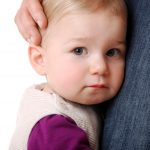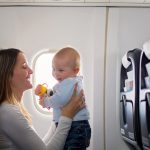 If just thinking about flying with a baby or toddler raises your stress level, rest assured that good preparation can set you up for fewer bumps in the road (or in this case, air). Let’s take a look at three key things to consider when preparing for air travel with your little one: Safety, gear, and packing.
If just thinking about flying with a baby or toddler raises your stress level, rest assured that good preparation can set you up for fewer bumps in the road (or in this case, air). Let’s take a look at three key things to consider when preparing for air travel with your little one: Safety, gear, and packing.
|
Highlights: There are three key things to consider when preparing for air travel with babies and toddlers: safety, gear, and packing. Safety:
Gear:
Packing:
|
SAFETY
When it comes to flying safely with little ones, experts suggest a few key things:
If your child has health issues (including an ear infection), get the green-light for air travel from your pediatrician.
For little ones who were born prematurely, have chronic heart or lung issues, or have respiratory symptoms, changes in air pressure during a flight may pose health risks. When it comes to ear infections, air pressure changes can cause children considerable ear pain.
Take steps to protect your child from germs.
Airplanes are notoriously germy, and little ones are vulnerable to getting sick. To reduce the chances of your child catching a contagious illness on board, bring sanitizing wipes to wipe down tray tables, arm rests, and other surfaces around your seat. Pack hand sanitizer to use periodically and before feeding/eating.
Consider purchasing a separate seat for your child.
Air travelers under age 2 are allowed to sit on a parent or caregiver’s lap rather than in their own seat, which can be a big money-saver. However, because most nonfatal in-flight injuries are caused by turbulence, the American Academy of Pediatrics recommends that babies and toddlers have their own seat and be secured in an FAA-approved CRS (child restraint system, such an infant car seat).
If you do go for the child-in-lap option, keep these points in mind:
- Your child may still need a boarding pass, or you may need a special notation on yours. Ask your airline about this ahead of time to avoid having to fix it at check-in.
- Bulkhead seats and seats in regular rows both have pros and cons. Bulkhead seats allow more space for legs, shifting things around, and getting in and out to use the bathroom. One downside is that you must stow your carry-on above the seat during take-off and landing, so you may be without some essentials for several minutes. Bulkhead seats also store tray tables in the arm rests, which can be cumbersome when you have a wiggly little one in your lap. In a regular row you will have slightly less room, but you can keep your carry-on under the seat in front of you and the tray tables are easier to manage.
- Window and aisle seats both have pros and cons as well. A window seat offers more privacy, and your little one may be entertained by looking out the window. The downside is that getting in and out to use the bathroom can be hassle. An aisle seat offers an easier route in and out of the row, but you must be continuously aware of keeping your child’s body parts out of the aisle so they don’t get bumped by beverage carts or other passengers.
GEAR
Here are a few questions about baby gear to ask your airline ahead of time:
- If you plan to use a car seat or other child-restraint system on the flight, is it approved by the airline?
- Does the airline check baby gear for free? Most airlines do this for car seats, booster seats, travel cribs and the like, but it’s a good idea to ask about your specific items so you know what to expect.
- Does the airline gate-check strollers? If so, where will you pick it up after landing? Again, most airlines will gate-check your stroller, but pick-up locations may vary.
PACKING
Be sure your carry-on is stocked with these essentials:
- Portable changing mat.
- Diapers: 1 for every 1-2 hours, plus a few extra in case of delays.
- Plastic bags for diaper disposal. There are times we’ll tell you not to worry about other passengers (like when your little one is crying). But when it comes to diapers, do your fellow travelers a favor and tightly close dirty diapers in plastic bags before tossing them in the trash.
- Diaper cream.
- Wipes for diaper changes, sticky hands, spills, etc.
- Hand sanitizer and sanitizing wipes.
- A change of clothes for your child and you in case you have a diaper accident, spit up episode or spill.
- A baby blanket for warmth, or to cover up if you want breastfeeding privacy.
- Drinks. If you’re traveling with a little one, the Transportation Security Association allows liquids like breastmilk, formula and water through security. They may ask to x-ray these liquids, especially if you have larger quantities.
- Snacks for older babies and toddler. If your baby can self-feed, a parent-approved trick is packing snacks like cut-up grapes, cereal or puffs that they can eat one-by-one, keeping themselves occupied and entertained.
- Some parents swear by reserving a few small toys for travel, so that their little ones are entertained by something new or something they don’t regularly play with.
- If your child uses pacifiers, pack 2 in case you drop one and can’t find it/clean it.
- Cotton balls or small earplugs for your little one’s ears, in case he’s sensitive to the noise in-flight.
Now that you’re prepared for your flight, head over here to read tips for a smooth travel day.








